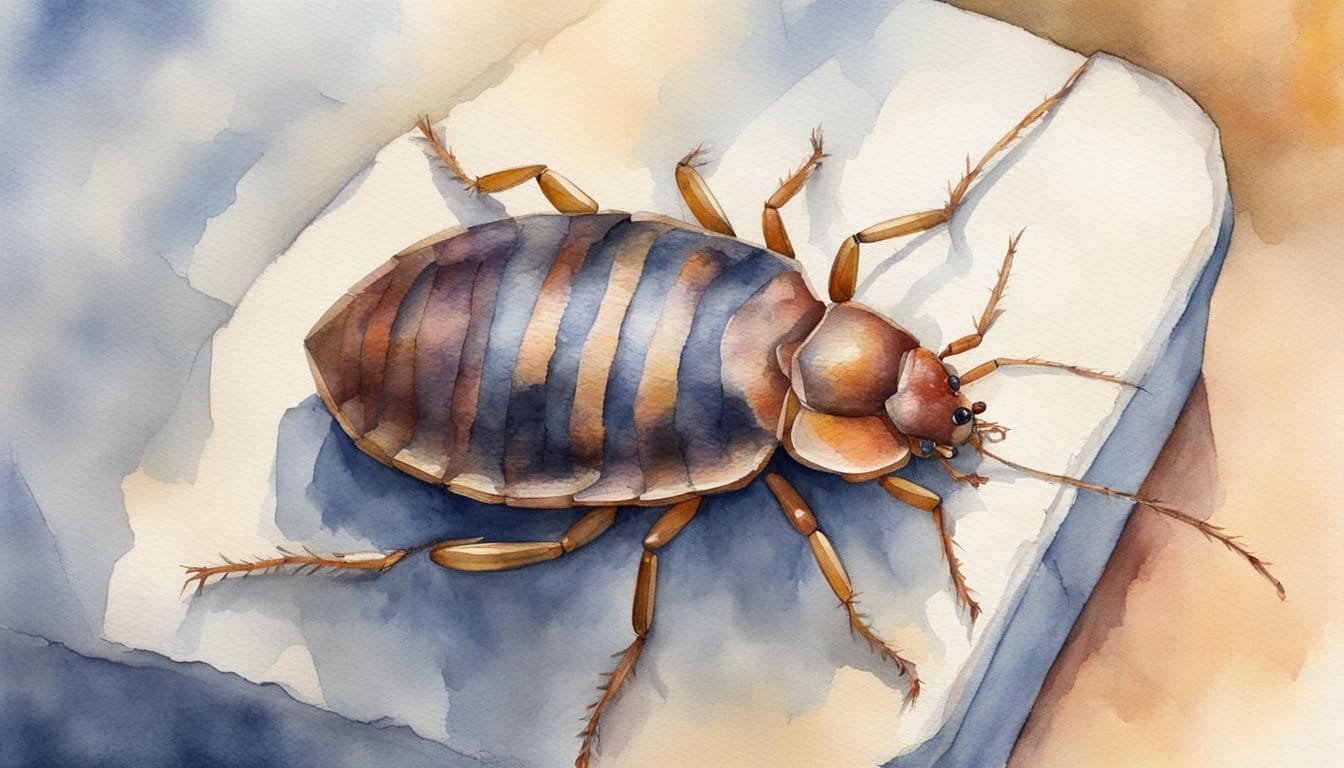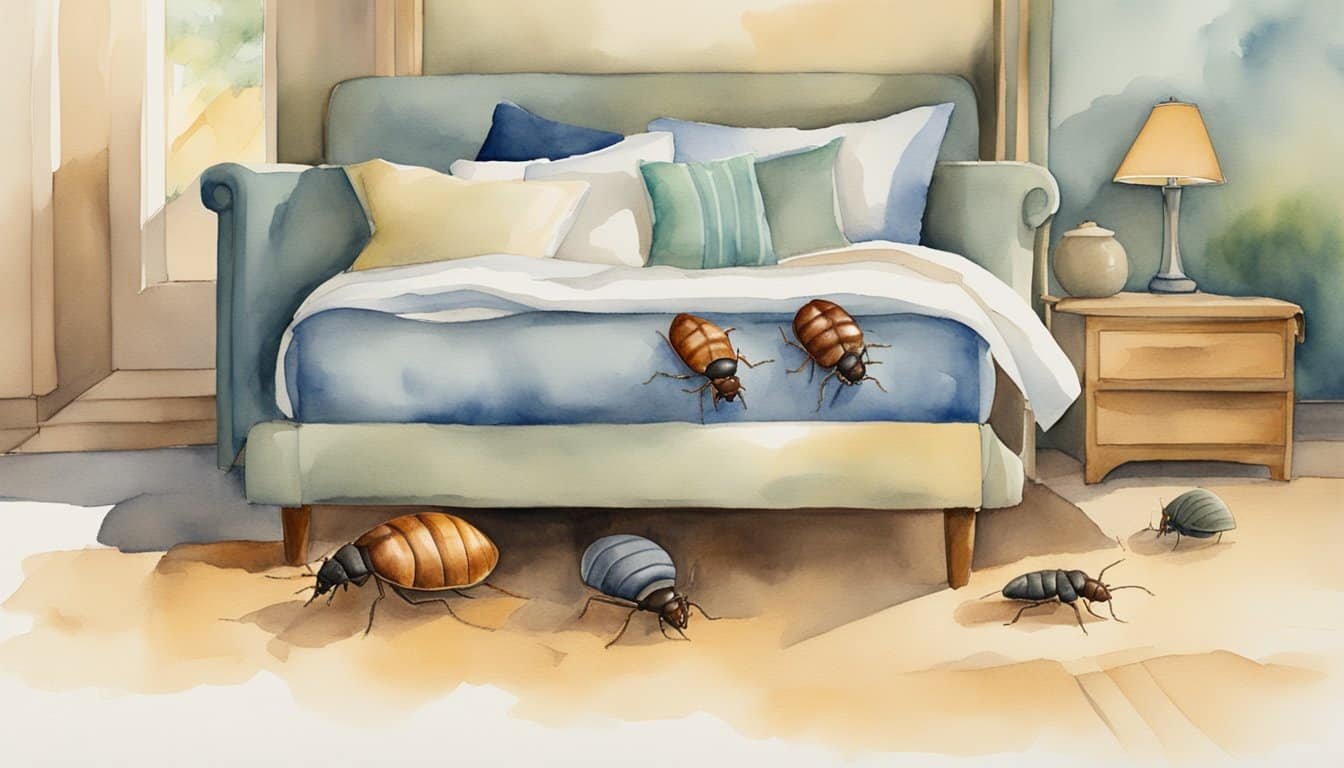Understanding Bed Bugs

Diving into the world of bed bugs is crucial to recognize and prevent infestations. These tiny critters may be small, but their impact on your home can be significant.
What Are Bed Bugs?
Bed bugs are reddish-brown insects notorious for their itch-inducing bites. They are small, about the size of an apple seed, and have flat bodies that make it easy for them to hide in the smallest of crevices. These pests are experts at hitching rides on luggage, clothing, and furniture, allowing them to spread rapidly.
- Color: Reddish-brown
- Shape: Flat and oval
- Size: Approximately 1mm to 7mm
Common Hiding Places
Bed bugs excel at the game of hide-and-seek, with certain favorite spots around the home. They prefer areas that are close to their food source—you!
- Mattresses and Box Springs: Prime real estate for these pests.
- Bed Frames and Headboards: Ideal for quick access to sleeping humans.
- Cracks and Crevices: Any small space can become a bed bug’s sanctuary.
- Furniture: Sofas and upholstered chairs are also attractive hideouts, especially if used for sleeping.
Remember, they’re not limited to the bedroom—these insects can make themselves at home in any part of a residence. Understanding their potential hideouts is the first step in stopping these unwanted guests in their tracks.
Recognizing Signs of Infestation

When it comes to bed bugs, early detection is key. Knowing what to look for can help prevent a small problem from becoming a full-blown infestation.
Spotting Bed Bugs
Scouring your living space for live bed bugs often feels like a game of hide-and-seek. These critters are experts at concealment, but they do leave clues. Adult bed bugs are small, about the size of an apple seed, and brownish in color, making them easier to spot than their minuscule offspring. More noticeable signs include:
- Blood spots on sheets or pillowcases
- Dark spots of bed bug excrement on mattresses, bedding, or walls
A distinct, musty odor may also indicate their presence, a telltale sign of a Cimex lectularius gathering.
Identifying Bites and Rashes
Bed bug bites often appear as red, itchy welts on the skin and may be confused with other insect bites. Unlike flea bites that are mainly around the ankles, bed bug bites can occur anywhere on the body. Here are some specifics:
- Bites typically form a line or cluster on the skin
- Skin problems such as rashes or hives may develop
- Some individuals may have an allergic reaction, intensifying itchiness or leading to more severe skin issues
Remember, not everyone reacts to bed bug bites so even if bites aren’t visible, that doesn’t rule out an infestation.
Causes and Spread of Bed Bugs

Bed bugs are crafty hitchhikers, adept at spreading through human activity. They thrive in places frequented by people, making the most of our movements to colonize new areas.
Travel and Transport
Travel plays a major role in the spread of bed bugs. They easily latch onto luggage, clothing, and personal items, using these as vehicles to move from place to place. Hotels, with their high turnover of guests, are common ground zero locations. From the luxury suites of cruise ships to the snug seats of buses and trains, no mode of transport is immune to these unwelcome passengers.
- Luggage: Bed bugs are often found in the seams and pockets, making international or domestic travel a prime opportunity for them to spread.
- Clothing: They can cling to fabrics, so a stay in an infested hotel room could lead to unexpected stowaways in your suitcase.
Secondhand Furniture and Items
Secondhand treasures can harbour these tiny pests. Whether it’s a vintage sofa or a gently-used nightstand, furniture offers bed bugs plenty of crevices to hide in. These items can turn your cozy apartment into a bed bug haven.
- Furniture: Bed bugs can survive for months without a meal, so even if a piece of furniture has been stored for a while, it might still host these pests.
- Apartments: The close proximity of living spaces makes it easy for bed bugs to travel across apartments, especially via shared walls or ventilation systems.
By understanding how bed bugs make use of our daily habits and possessions, we can be more vigilant in preventing their spread.
Preventing Bed Bug Infestations
Getting rid of bed bugs can be a challenge, but preventing them is key in maintaining a comfortable and pest-free home. Engaging in proactive measures can greatly reduce the likelihood of an infestation.
Protective Measures at Home
Regular Inspection: Regularly check the seams of your mattress and box spring for signs of bed bugs. These insects tend to hide in tight spaces, so keeping a watchful eye is essential.
- Use protective covers designed for mattresses and box springs, which can deter bed bugs from entering or escaping.
- Declutter your space to reduce hiding spots for these pests.
- Vacuum frequently to remove any potential bed bugs and their eggs, paying close attention to baseboards, furniture, and other crevices.
Precautions While Traveling
Be Vigilant: When staying in hotels or other accommodations, one should always be vigilant to avoid bringing bed bugs back home.
- Inspect the hotel mattress, particularly the seams, for any signs of bed bugs before settling in.
- Keep luggage on a rack away from the bed and wall to minimize the risk of any bed bugs hitching a ride home.
- Upon returning home, immediately wash all clothes in hot water and vacuum out your suitcase to eliminate any potential stowaways.
By adhering to these strategies, individuals can minimize their risk of a bed bug infestation and enjoy a more peaceful and comfortable living environment.
Treatment and Control

When bed bugs creep into a home, they can be stubborn squatters. Effective management demands a combination of professional services and practical home interventions.
Professional Pest Control
Professional pest control typically involves an expert’s assessment, followed by a tailored treatment plan. It often begins with an inspection to locate where the bed bugs are hiding. Pest control professionals may use a variety of methods to eradicate bed bugs, such as heat treatments, which raise the temperature of the affected area to a level that is lethal to bed bugs. Another method is the application of insecticides that are specifically labeled for bed bug extermination. Companies like Orkin provide insights on how prevalent bed bug infestations can be, indicating that certain cities might be more affected based on the volume of bed bug treatments they undertake.
Home Remedies and DIY Solutions
For those inclined towards DIY approaches, several home remedies can aid in controlling a bed bug situation. Vacuuming all areas where bed bugs might travel is a fundamental step. Sealing gaps in furniture and walls denies bed bugs hiding spots. Furthermore, laundering bedding, curtains, and clothing in hot water followed by a spin in the dryer on high heat can kill bed bugs lurking within fabrics. Some people use diatomaceous earth by sprinkling it around bed frames and other bed bug passages. However, for these methods to be effective, consistency is key, and they are often most effective when combined with professional pest control efforts. It’s important to note that while DIY solutions can be part of the control strategy, they are rarely sufficient on their own to completely eradicate bed bugs.
In cases of severe or extensive infestations, or when bites become problematic, consulting a doctor for medical advice or treatment could be necessary. A physician might prescribe treatments to alleviate the itching and discomfort caused by bed bug bites.

